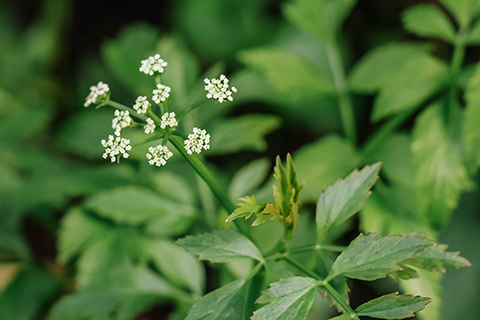Invasive plants are a concern because they reduce habitat for native wildlife. Because of their ability to spread quickly, they often out-compete native plants and “take over” habitats.
Invasives often emerge earlier in the spring and push natives out through fast reproduction. This limits habitat available for native wildlife and disrupts the food chain.
One example is the invasive plant, garlic mustard. Native butterflies lay eggs on garlic mustard, and they either die or the caterpillars don’t properly grow.
It’s easier and cheaper to control invasive plants when only a few individuals or populations need to be treated.
Being aware of potential invaders and being prepared with early detection and rapid response is critical for limiting their negative impacts.
Emerging Invasive Concerns
Pennsylvania monitors invasive plant species that are up-and-coming threats. Here are five invasive plants to be on the lookout for in Pennsylvania. They have not yet been observed in the state or they are only known in certain locations.
These plant species were ranked as invasive using information available from invasive species databases, scientific literature, expert opinion, and observation by the Pennsylvania Natural Heritage Program through a Wild Resource Conservation Program-funded project.
Diffuse Knapweed

Diffuse knapweed (Centaurea diffusa) is native to the eastern Mediterranean region. It resembles its cousin, spotted knapweed, and utilizes open disturbed areas such as plains, rangelands, and open forest areas with light, dry, porous soils.
It was first observed in North America in the early 1900s likely because of contaminated seed.
This species forms large stands that crowd out native plants, deplete soil and water resources, and decrease biodiversity.
It also produces a chemical that inhibits other plants from growing.
Diffuse knapweed is prolific -- one plant can produce up to almost 20,000 seeds, which can lie dormant in the soil for several years.
It has been found to the north and west of Pennsylvania, including neighbors Ohio, New York, and New Jersey.
Marsh Thistle

Marsh thistle (Cirsium palustre) is native to Europe and Siberia. As the name suggests, marsh thistle prefers areas of moist, acidic ground including wetlands, wet fields, wet ditches, riparian areas, and edges of wet woods.
This species has a long history of being spread by humans and agriculture.
This prickly plant creates dense stands that crowd native plants out and decrease habitat for native wildlife.
It can produce up to 2,000 wind-borne seeds per plant. The reduction in biodiversity and species diversity this plant creates can be detrimental where rare species exist.
Marsh thistle has been observed in New England, Canada, and the Great Lakes States, as well as Clinton County, Pa.
Swamp Stonecrop

Swamp stonecrop (Crassula helmsii) is a wetland plant that can grow in mud, or partially submerged in still or flowing water.
This succulent plant carpets the ground in wet areas, competing with native vegetation and blocking drainage channels and causing flooding.
It can deplete oxygen levels from the water, making habitat unsuitable for wildlife like frogs and fish.
It’s a native to Australia and New Zealand and is a problem in Europe and Great Britain; but has not been documented yet in North America.
Water Soldier

Water soldier (Stratiotes aloides) was first introduced as an aquatic ornamental plant and prefers slow water of canals, ponds, and ditches. It can also be found in shallow water of sheltered bays and large lakes.
It forms dense mats that can crowd out native wetland plants, decreasing biodiversity and species abundance.
It is also harmful to recreation, because the sharp serrated leaves can be dangerous to swimmers or others who try to handle the plant.
Water soldier looks similar to arrowhead, eel-grass, or bur-reed, but the serrated edges help identify it. So far, the only place water soldier has been found in North America is Ontario.
Java Dropwort

Java dropwort (Oenanthe javanica) is a native of East Asia and Australia.
This plant was introduced into North America as an ornamental wetland plant.
It also is sometimes marketed as an exotic vegetable and medicinal herb; however, it escapes cultivation.
Java dropwort grows aggressively and can form dense colonies and spread into wetlands and choke streams and waterways.
It can root from broken fragments of the plant, which allow it to spread even more quickly. Dense colonies of this plant decrease biodiversity, ecological integrity, and recreational value.
Java dropwort has been found in Virginia, Georgia, and Indiana.
How You Can Help Stop the Spread
Learning to identify invasive plants is the first step in understanding and combatting the problem. If you see one these species -- report them at the Pennsylvania iMapInvasives website!
Invasives can be difficult to control, but by taking some steps at home and in the wild, you can help limit the spread of these troublesome plants.
Learn more about these and other emerging invasive plants at the PA iMapInvasives website.
Learn more about invasive plants in Pennsylvania and how you can help control their spread at DCNR’s website.